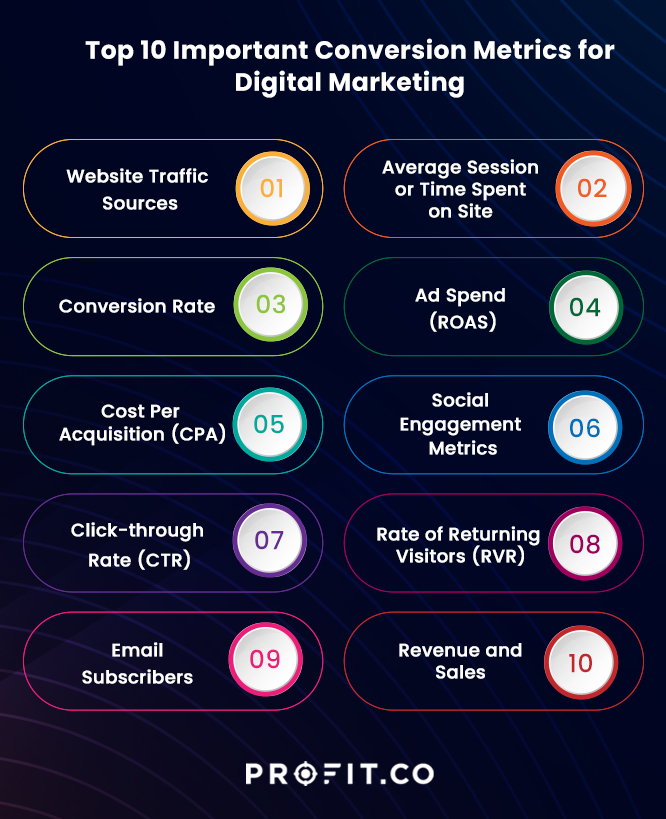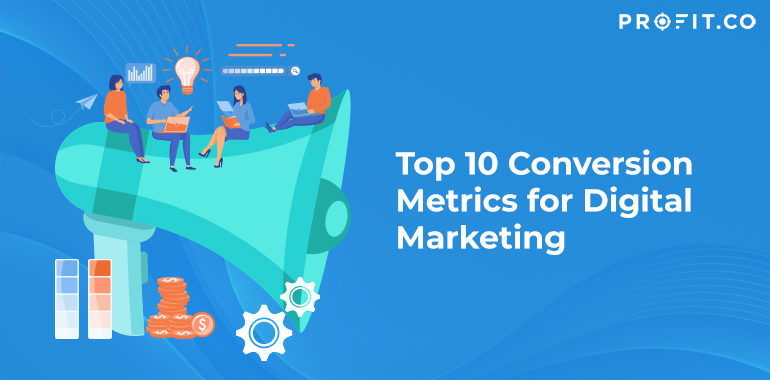Introduction
More than a sound digital marketing strategy is needed to ensure success. There is only one way to measure your digital marketing strategy, and that’s through tracking metrics. Although a digital marketing campaign generates tons of information, one essential data point is conversion metrics. These metrics apply to every business seeking to maintain a competitive advantage online.
This Guide Contains
- What Are Conversion Metrics?
- Conversion Metrics definition
- Importance of Conversion Metrics in Digital Marketing
- The top 10 conversion metrics you should track
What Are Conversion Metrics?
Conversion metrics refer to how your customers or audiences behave toward your digital marketing content. In other words, the conversion metrics definition is a key performance indicator (KPI) that measures if your online marketing strategy achieves its desired effect of conversion.
Definition
A conversion in digital marketing means the action you want your customer or audience to take when interacting with your content. This action begins your customer’s journey through the sales funnel and typically ends with a purchase. Since conversions are different for every business, it’s essential to know which conversion metrics to track to match your company’s goals and objectives. Otherwise, you may get distracted by data that does little for your bottom line.
Importance of Conversion Metrics in Digital Marketing
As mentioned in the conversion metrics definition above, keeping track of your digital content performance can improve your strategy. Conversion metrics help you to:
- Optimize your web and social media pages
- Set achievable marketing goals and targets
- Determine the most compelling call to action to drive conversion
- Keep tabs on your digital marketing budget
In general, conversion metrics serve as a decision-making tool. Digital marketers can use these metrics to make data-driven choices that improve the overall marketing strategy.
Examples of Conversions
Some common examples of conversions are:
- Email newsletter sign-ups
- Registering for a webinar
- Downloading resources like ebooks or white papers
- Completing a purchase
- Scanning a QR code
- Completing a survey
- Writing a review, etc.
Of course, conversions vary by product and industry. For example, an online clothing retail store may want its audience to redeem discounts or sign up for offers. On the other hand, a software company may want its audience to try a demo or upgrade a license subscription. Choose the conversion that suits your business, then track your performance accordingly. The time-tested OKR methodology, a goal management platform that allows organizations to use objectives and metrics to measure the progress of their goals can also be used by Businesses. Book a free demo with our team to learn more about how OKR software can optimize your organization’s performance!

10 Most Important Conversion Metrics for Digital Marketing
Track the following essential conversion metrics for your digital marketing campaigns:
- Website Traffic Sources
Knowing where your online visitors come from allows you to target your marketing efforts to the proper channels. Some traffic sources include:
- Direct sources like bookmarks or typing a URL into the browser
- Links from emails, social pages, or other sites
- Search engines
- Online ads, etc
Use search engine optimization (SEO) and other digital marketing tactics to drive traffic to your content.
- Average Session, or Time Spent on Site
Another conversion metric to track is how long visitors stay on your website. This is called session time or time on site (TOS). This metric monitors your content’s quality since users spend more time on valuable, well-crafted content. You can calculate your TOS for the entire website or specific pages. Users typically spend more time on pages about pricing and how-tos rather than about us pages or sign-up pages.
Tip: Use a reading meter plugin to give your visitors an estimate of how much time they’ll spend on your page. Compare this figure with your session time data from Google Analytics. If the numbers match, your visitors are reading your content to the end. If not, revise your content to improve engagement and retention.
- Conversion Rate
One of the most popular and valuable conversion metrics is conversion rate, it indicates the number of visitors who took the desired action or completed your marketing goal. Calculate the conversion rate with the formula below:

For example, a company website may get 10,000 visitors in a given month, but only 200 sign up for email updates. In this case, the conversion rate is (200 / 10,000) x 100, which is 2%. This figure is the average conversion rate for most businesses, but it could range from less than 1% to 10%, depending on your industry.

Data is becoming the new raw material of business.
- Ad Spend (ROAS)
You also need conversion metrics to monitor your marketing budget. The most effective metric for this is the return on ad spend (ROAS), which shows you how much you make for every dollar you spend. Calculate ROAS using the formula:

Let’s say you spend $300 on digital ads that fetch $1,000 in sales. In that case, ROAS is (1,000 – 300) / 300, which is $2.33. This means you gain just over $2 for every $1 you spend on online ads. Always ensure that your ads break even or bring in more than you spend on them.
- Cost Per Acquisition (CPA)
Like ROAS, the cost per acquisition (CPA) metric shows how much you spend to gain new customers. However, it includes your entire digital marketing budget, not just your digital ad campaigns. Calculate CPA with the formula:

A high CPA means that you should revisit your digital marketing strategy and search for avenues that cost less to capture leads and customers.
- Social Engagement Metrics
Digital marketers can also use conversion metrics to track content performance on social media. You can do this in two ways:
- Add social sharing buttons on your web pages and check their counters
- Check your social media analytics pages for insights
Social pages drive traffic to your website when users share your content, which signals your most engaging content. At the same time, users click through the content you share on your pages to read your blog post, watch your videos, download your white paper, and so on. Social engagement, therefore, contributes to other conversion metrics, including conversion rates, CPA, and session time.
- Click-through Rate (CTR)
If you’re investing in online ads or a blog content strategy, you need to know how well your copy performs on emails, search engines, and other ad platforms. The click-through rate (CTR) is a great way to monitor your headlines, title tags, and ad copy, and it also helps you to conduct A/B tests to appeal to your audience. Calculate CTR with the formula:

Aim for an average CTR of 2.5% for your email campaigns. In comparison, digital ads (search and display) can range from 0.5% to 4%, depending on your industry.
- Rate of Returning Visitors (RVR)
Digital marketers should create such valuable content that visitors return for more. This is the difference between your overall traffic metrics and your rate of returning visitors (RVR) metrics. Calculate RVR using the formula:

Tip: Although returning visitors can come from any source, your most reliable metric is direct traffic. It indicates users who type your URL directly into their browsers or type the first few letters, and the browser auto-fills the rest from history. Compare this metric with the time spent on site to identify audience trends.
- Email Subscribers
Emails have the highest return on investment (ROI) of all marketing channels, giving you $42 for every dollar. In addition, email subscribers are often the most engaged audience segment, which is why you need conversion metrics to retain them.
Track email subscribers by sources to see where the newest sign-ups come from, then create engaging submission forms to capture their data. Also, use platforms like Mailchimp and Drip to personalize and automate your emails.
- Revenue and Sales
Lastly, track every transaction attributed to your digital marketing campaign and see how much revenue you gain. Gross and net revenue are valuable conversion metrics for businesses that run e-commerce sites. Analyze sales according to traffic sources, social channels, email campaigns, and other segments. You can then reinvest the revenue into the best-performing avenues to generate more profits.
FAQs
- What are conversion metrics in digital marketing?
Conversion metrics are key performance indicators of your audience’s response to your call to action.
- What are conversion examples?
Conversions examples include email subscriptions, content downloads, webinar or podcast sign-ups, product purchases, reviews, or any other audience action you want from your marketing campaigns.
- What are the critical conversion metrics for digital marketers?
Conversion metrics include website traffic, social media engagement, click-through rate, time spent on site, and return on ad spend (ROAS).
- How often do you report conversion metrics?
While you should monitor conversion metrics throughout, you gain the best insights from monthly reports. These indicate changes in audience behavior, revenue, competitors, etc.
Conclusion
Numerous tools are available for tracking conversion metrics, from Google Analytics to paid solutions like Tableau and Geckoboard. Built-in dashboards on social media platforms also provide conversion metrics to monitor your content. Keep in mind that no metrics platform can retroactively monitor your performance.
Therefore, regardless of your chosen tool, the imperative moment to commence monitoring conversion metrics is now. Identify the most valuable marketing KPIs for your business, clearly define your conversion metrics, and embark on the journey. Alongside, organizations can effectively track their marketing strategy through objectives and key results (OKRs), including marketing OKRs, using an agile OKR Software platform that facilitates tracking progress. You can get started on Profit.co completely free today!
